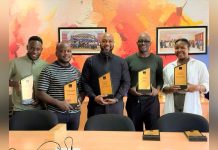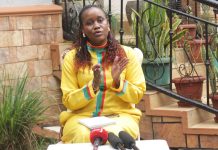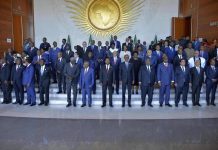Africa-Press – Uganda. The docuseries Tuko Pamoja (We Are One) explores Uganda’s sense of identity and togetherness or belonging as a post-colonial nation, heroes from the country’s pre-colonial history, and what Uganda could borrow from history to solve contemporary challenges.
Written by Rogers Atukunda and directed by Cindy Evelyn Magara Amooti, the documentary series constructs and deconstructs history by interviewing historians, various cultural leaders, and opinion leaders in the country.
It explores the unifying political, economic and cultural heritage of the people of the Great Lakes region traced from the great Bunyoro-Kitara Empire that covered the current entire Uganda, extended to Rwanda, Burundi, northern Tanganyika, Ituri Forest in the Democratic Republic of the Congo (DRC), large parts of Kenya, and Sudan up to Gondokoro.
The docuseries that premiered in February in Kampala, and runs up to June, has 13 segments. They include: Bunyoro-Kitara Kingdom; Buganda; Tooro; Karo Karungi: Ankore (Ankole and The Mporo States, Buhweju); Kigezi (Bafumbira, Bakiga and Batwa); Labongo Land (Acholi and Jopadhola); Gipiri Land (Alur);
The ‘Ango’ people: Lango, Karamajong, Teso; Bukedi Land: Basoga, Bagisu, Babukhusu, Samya, Bagwe; The Rwenzori (Rwenzururu/Rwenjura) people: Bakonjo, Bamba and Basongora; Lado Enclave/West Nilers: (Lugbara, Aringa, Madi, Kakwa); Break Away Kingdoms: Bunyara, Buruli, Kooki; and Uganda: The Making of a Nation.
The segments
Bunyoro-Kitara is the first segment because its history encapsulates the thesis of the series. It premiered at the National Theatre in Kampala on February 3 and was screened at Ham Cinemax from February 4 to 10.
The second segment, Buganda, is one of the embryonic kingdoms that grew from a mere three counties to become a nation within a nation. It has strong links with Bunyoro and Bugisu hence the Tukopamojaness! This particular segment premiered at the National Theatre on February 11, and it screened at the National Theatre on February 13, 19 and 20, and all week at Ham Cinemax.
Busoga is closely linked to Bunyoro and Buganda from their oral history and collective memory. The rebellious princes from Bunyoro and Buganda always took refuge in Busoga. It was and it is still a gateway into Uganda. It premiered at the National Theatre on February 21 and screened at Ham Cinemax for a week.
Ankole brings on screen people linked to Bunyoro and Rwanda, who had a great history, but their history is in a museum. It premiered at the National Theatre on February 28 and screened at Ham Cinemax for a week.
The ‘Ango’ people: Lango, Karamojong and Itesots segment shows the connections of the Ateker people. It particularly highlights the role played by the Langi. The Langi, who are Ateker by DNA and Luo by language, stand out as significant in the history of Uganda since they were protecting Omukama Kabalega and Kabaka Mwanga in Kangai. It premiered at National Theatre on March 10 and screened at the National Theatre and Ham Cinemax for a week.
The segment on the Bagisu and Babukusu as well as Samia and Bagwe (The Luhyas) underscores the hybridity that results from two ethnic groups—the Nilotics and the Bantu. The Berlin drawn borders that divide people into different countries—and the disregard—come into focus. The segment premiered at National Theatre on March 23 and later screened at Ham Cinemas.
Tooro is joined at the hip with Bunyoro-Kitara. The two are closely linked to their ancestors—the Luo, whose names they adorn as praise names (Amooti, Abwooli, Akiiki, and Abbala, among others). This segment premiered on April 6, 2024 at Ndere Centre.
The Luo segment amalgamates the land of Labongo and Gipir. Spread all over Uganda and the Great Lakes Region, the Luo’s civilisation is felt in all parts of this world because they were and still are the rulers of the major kingdoms in the region. It premiered on April 20, at Ndere Centre.
Other segments
The segment on Kigezi speaks to the Bafumbira, Bakiga and Batwa. It underscores the impact of artificial borders and the fact that Ugandans and Rwandans are one. It will premiere on May 4 at Ndere Centre.
The Lado Enclave segment will bring the West Nilers (Lugbara, Aringa, Madi and Kakwa) within eyeshot. These cousins of Luo mostly intermarried among the Banyoro. They in fact have a village called Worokomba (Muzungu ends here), but their chief resister, a chief Aliku is not among the main stream resisters of foreign aggression. Tuko Pamoja weaves a story of people who were tossed from the DRC to Uganda; yet are still divided by the artificial border from their kins in the DRC and Sudan. It shall premiere on May 11 at Ndere Centre.
The docuseries also looks at the breakaway kingdoms—Bunyala, Buruuli and Kooki. At the time when nations are aspiring to federate, one wonders why the chiefdoms want to create independent kingdoms. The answer is in history, and will have to wait until May 18 when this segment with a teasing ‘to be or not to be’ tagline premieres at Ndere Centre.
Elsewhere, the segment on the Kingdoms of the Mountains of Moon (Rwenzururu/Rwenjura) will explore the injustice the Berlin Conference visited upon the people of the Rwenzori Mountains (Bakonjo, Bamba and Basongora). Almost everyone has a relative in the DRC. It premieres on May 25 at Ndere Centre.
After establishing how the various people of Uganda are interconnected, Tuko Pamoja has a segment that delves into how the said people are clamped together in Uganda. It also explores how they foster national unity. It will premiere on June 1 at Ndere Centre.
Influences
According to Magara, Tuko Pamoja started as a research journey into the life and reign of Uganda’s most famous colonial resisters—Omukama Kabalega of Bunyoro-Kitara Kingdom, Kabaka Mwanga of Buganda Kingdom, and Chief Awich of Payira Chiefdom in Acholi.
“We intended to make an epic film of these figures. However, we needed firsthand accounts from elders, historians, and ordinary people randomly picked on the street to see how they remember their pre-colonial monarchs,” Magara told.
Magara added: “As we delved deeper into their stories, we realised that to do justice to their legacies, there was a need to recognise other Ugandans outside Bunyoro, Buganda and Acholi, who resisted, albeit in different ways. Besides resistance, although it is the most audacious thing to have been done by these leaders, we realised that you cannot talk about Kabalega, Mwanga and Awich without talking about their compatriots. Besides, a close look at these leaders implies a 360-degree view of Uganda. This is because the pre-colonial leaders collaborated or at least had squabbles among themselves.”
She was also alive to the existence of cordial relations such as the one Kabalega had “with Chief Katuregye of the current-day Kigezi region.”
The Omukama also “got his weapons from the West Nile, and married women from Acholi, Tooro, and Wanga, among others.” While both Kabalega and Mwanga were on the run, they received aid and shelter from Acholi and Langi warriors, especially, added Magara, “Chief Awich Abok of Payira Chiefdom and the famous Lango warriors in Kangai (Dokolo District).”
More legroom
When Magara came to the realisation that “Kabalega and Mwanga cannot be squeezed into a feature film” spanning three hours, she settled for a docuseries that offers more legroom.
“As such, this documentary would also serve as a springboard to a mega fundraising campaign to raise resources from Ugandans, east Africans and any well-wisher to make a live-action series titled Conquer or Die,” Magara told, adding that Conquer or Die is intended to be the Great Lakes’ answer to Game of Thrones with King Kabalega as the protagonist in the last quarter of the 19th Century.
Magara noted that “if about 10 million people gave us one dollar each, we would have $10 million to start the epic production.” For now, she is taking great delight in the legroom Tuko Pamoja has afforded her project. The docuseries, she offers, “addresses loss of identity, cultural confusion, the negative effects of hybridity, neocolonialism, self-hate (because there is nothing positive popularised about our heritage), tribalism and ethnic divisions, and decolonisation, among others.”
As the docuseries’ title suggests, Tuko Pamoja looks at Africa’s unity in diversity. It primarily constructs and deconstructs history by interviewing historians, various cultural leaders, opinion leaders, and youth in Uganda.
“Guided by the oral tradition culture, I went into the community to seek an in-depth understanding of the construction of cultural identity/ethnicity and how they relate or fit in the larger Uganda that is seen to have closely linked yet diverse people,” she said.
She added: “For each community, we explore how they responded to the slave trade and British colonialism, the most tumultuous times for the people of Africa, and how they made an indelible mark on Africa […] yet the colonialists wanted to see us divided on, for example, along tribal lines to subjugate us. When we all know this history, it will reduce ethnic tensions.”
Interconnectedness
According to Magara, Bunyoro’s rulers were all related. “They kept intermarrying, and their children formed new dynasties. The old Kitara ruled the Great Lakes Region, and the sons of the kings of Bunyoro kept breaking away, forming new kingdoms in the region. They met different people, and they either unified the area with war and blood brotherhood (ceremony of sharing blood in friendship) or married their daughters to unify the region.”
She proceeded to note: “Firstly, the rulers of Bunyoro, Buganda, Busoga and Tooro are all Babiito (Bito-Luos from northern Uganda). The Babiito, first settled in present-day Bunyoro before continuing their movement back into northern Uganda, eastern DR Congo, Kenya and Tanzania. Their linguistic affinity entails their connectivity.”
She added: “Secondly, the rulers of Ankole (Bahinda) were cattle keepers in charge of the royal herds of Bunyoro kings before breaking away to form their separate kingdom. The founder of Nkore, Ruhinda rwa Njunaki, was the son of the last Muchwezi king of Bunyoro, Wamara. After founding Nkore (Kaaro-Karungi), Ruhinda proceeded to Tanzania and founded the Karagwe Kingdom. That is a quick demonstration of our interconnectedness.”
Uganda, Atukunda said, existed even before colonialism. “It may not have existed as a single entity, but it had the kingdoms like Bunyoro, Buganda, Tooro, Ankole, among others, and non-kingdom areas that composed it. These kingdoms were trading with each other, they were intermarrying, and their people were mixing and fusing.”
He pointed out the first rulers of Bunyoro, the Batembuzi. They are said to have been of Madi origin, adding that “their successors, the Bachwezi, originate from Princess Nyinamwiru, daughter of the last Mutembuzi King Bukuku and a son to the second last Mutembuzi King Isaza and his wife Nyamata, a princess from Nkore Kingdom.”
The Babiito were sons of a Muchwezi, Prince Kyoma, and Nyatwor, an Acholi-Lango princess.
“When all linguistic groups migrated to Uganda, they kept mixing wherever they settled. Because of these intermarriages, most of us share the blood of different ethnic groups. We can’t claim to be pure Nilotic or pure Bantu,” Atukunda discloses.
Warm reception
Magara said the docuseries has been warmly received thus far. “We have got numerous calls from people wanting to tell us their stories. The people are generally happy with Tuko Pamoja for giving them the voice to articulate their history. I think Tuko Pamoja is a turning point for Africans to appreciate our heritage and identity. We have received positive commendations and encouragement from leaders and individuals, including an award given to me on March 30, by Kabalega Foundation and Bunyoro-Kitara Kingdom for my contribution to film and literature.”
Asked what the legacy of Bunyoro-Kitara in terms of culture, political administration and war tactics is, Atukunda told thus: “Most kingdoms and people of the interlacustrine region share the same culture, thanks to Bunyoro-Kitara. These include the foods, music, dance, burial customs, and regalia.”
He added: “Politically, the sazas (counties) which originate from the famous Mutembuzi King Isaza Nyakikoto have remained part of our administrative structure. Bunyoro kings had already created the position of prime minister and had a Parliament as early as the Bachwezi era. They had a legal system, trade markets and even formed standing armies. Are our modern systems that much different?”
According to Atukunda, “in terms of war strategies and tactics, Bunyoro’s warrior king Kabalega already had the knowledge of subterranean warfare even before interaction with the Whites. When Col Colvile attacked his capital Mparo in 1893, Kabalega dug tunnels and embarked on guerrilla war tactics to the surprise of a people who thought they had mastered the art of warfare. And indeed, he defeated Colvile several times.”
He added: “His (Kabalega) guerrilla war tactics have been employed by modern governments, including that of President Museveni, making it easy for a smaller force with inferior weapons to defeat a large force with superior weapons. Kabalega’s tunnel warfare was employed by his successor Chief Awich of Payira to defeat the British during the Anglo-Payira wars as well as the Lamogi Rebellion of 1911. The same tactics were used in the so-called World Wars.”
Why a docuseries?
When asked why they settled for docuseries cinematic format to disseminate this knowledge, Magara replied: “The original plan was to make an epic film. We detoured to make a documentary film first. The documentary was, in some sense, research because of the general contestation of African history as being told from the hunters’ (colonialists) point of view. So we decided to centre the bearers of history: Court historians, senior citizens, academics, leaders, and ordinary people in telling us their history.”
“This would only make sense to this orate community (that was going to receive this documentary first when it has a semblance of someone telling a story to another—hence the participative approach. We, thus, have a documentary film using a relatable mode of history archival—orality and story to collect information that cannot be found in history books,” she added.
“We were also cognisant of our orality reality: most people do not want to read information captured in written books. We thought this audiovisual medium would not only appeal to the young audiences (the target of this documentary and the majority in Africa, but also preserve the history in a more friendly and modern format: digital. The audiovisual is versatile,” she further added.
The underlying theme of the docuseries is to highlight the oneness of Ugandans.
“…once people know their history, it will reduce ethnic tensions. The border of the Bunyoro-Kitara Empire illustrates that the East African community that we are trying to build today already existed then. Bunyoro’s trade was the glue. Possibly, East Africans’ memory of their not-so-old history would fast-track their integration and the Africa Union,” Magara told.
She said after the Kampala premieres and cinema screenings of the Tuko Pamoja segments, they will have up-country premieres across all major towns and cities of Uganda. Thereafter, the series will be screened on major local television stations. After the one-off TV screenings, the series shall be up for streaming on Nyati Films App.
Who they are
Cindy Evelyn Magara Amooti
Magara is a Ugandan film director and academic. She is a lecturer in film and literature at Makerere University in Kampala. Her research revolves around emergent representations in African film; the intersection of children’s literature and film; national cinemas, the griot aesthetics in African literature and film, contemporary film theory and ‘World Cinema;’ gender power struggle and immigration narratives in relation to African screen media; structures of film production, distribution, and exhibition in East Africa.
She holds a Bachelor of Arts in Film and Literature (2002-2005) and a Masters in Literature (2014) from Makerere University. In 2021, she graduated with a PhD in African cinema from the University of Sydney, Australia.
Magara has directed and produced three fiction feature films: Fate (2006), Fair Play (2010) and Windows of Hope (2011).
Rogers Atukunda
Atukunda is a journalist and budding filmmaker. He holds a Bachelor’s degree in Education (Literature and English Language) from Makerere University.
Atukunda’s film journey started in 2011 when he won a $2,000 award for the script for the short film Me and Myself at the Maisha Film Lab founded by the Hollywood director Mira Nair. He directed and produced Me and Myself (2012), which later won the Best Short Film award at the 2014 Pearl International Film Festival (PIFF).
He worked as an assistant director, screenwriter and producer of a mini-feature Breaking the Mesh (2012) by Makerere film students, which won the Best Student Film award at PIFF 2014. This film premiered at the Zanzibar Film Festival and was chosen for screening/broadcasting by DStv Uganda.
Atukunda worked as an assistant director on a feature film Hang Out (2013) by Kennedy Kihire, and a production designer on Gotto (2012) a film by Tony Angelo and Kennedy Kihire.
He is currently writing a children’s film script, Paparazzi. He is also working on an Afro-history project, which includes a documentary, Tuko Pamoja, and an epic/historical series, Conquer or Die, which features Uganda’s pre-colonial heroes.
Source: Monitor
For More News And Analysis About Uganda Follow Africa-Press






